Print this page and take it shopping.
There are too many to count. There are small disposable units for tailgating, and huge monsters that attach to your tailgate and have as many wheels as your SUV.
And they range in price. A nice hibachi that will make great steaks (really) can be had for only $15, and not long ago I saw a stainless steel job with six wheels in an Ace Hardware that said "Financing Available" (really)!
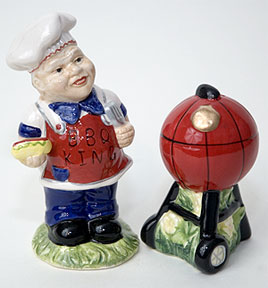 A good grill is an essential tool for the modern cook, not just as a backyard diversion, but a second oven. What it does best is create meat, seafood, and vegetables with a unique flavor, and, because of the high heat, it can come closer to turning out steakhouse meat than anything you can do with most indoor ovens. If configured properly it can even smoke roast low and slow as well as a dedicated smoker.
A good grill is an essential tool for the modern cook, not just as a backyard diversion, but a second oven. What it does best is create meat, seafood, and vegetables with a unique flavor, and, because of the high heat, it can come closer to turning out steakhouse meat than anything you can do with most indoor ovens. If configured properly it can even smoke roast low and slow as well as a dedicated smoker.
Here's a guide to helping you decide what features you want when shopping for a grill. Tune in next week for an article on what to look for in a smoker. A few weeks ago I tried to settle the debate over gas vs charcoal in HuffPo.
Things to look for
Size matters. The first decision is size, which relates to price. Start by looking at the number of square inches of cooking surface. Square inches are calculated by multiplying the length by the width of the primary cooking surface. Beware that some grills have an upper shelf for keeping food warm and some manufacturers include this in their square inch statement. When deciding how much surface you need, remember that you do not want to crowd a grill, that you should leave at least an inch between steaks or other things being cooked. Rule of thumb: Allow about 100 square inches (10" x 10") per person. Ask yourself how many people will you normally be cooking for. Don't forget the July 4 party.
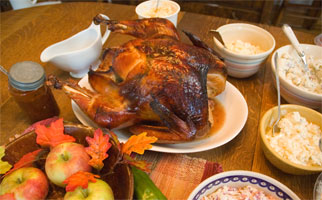 Head space. You will want enough room to smoke a turkey, so make there is at least 1' of head space between the cooking grate and the inside of the lid.
Head space. You will want enough room to smoke a turkey, so make there is at least 1' of head space between the cooking grate and the inside of the lid.
Price. What is the bottom line? Prices can go up to $5,000 for some gas grills. Remember, the more options, the more expensive. Good charcoal grills run $100-300. The old reliable, very capable, versatile, and indestructible Weber Kettle can be had for under $100. You can get a really nice gas unit for $200-400, and be the envy of the neighborhood for $800. But keep in mind, quality does not necessarily increase with price. A lot of the $1000 units I've seen do not out perform some $400 units.
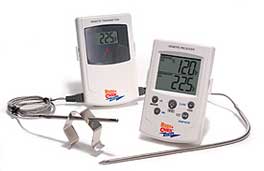 Temperature control. The key to successful cooking is temperature control. A good grill should allow you to setup multi-zone cooking with at least two zones. One zone for high heat cooking, another for slower, lower heat cooking. For more on this important concept, read my article on 2-Zone and Indirect Cooking. Charcoal grills need tight lids and dampers that can be opened or closed to control oxygen to the fire and thus control the heat. Some have the ability to raise and lower the coals. This is a very good thing. Can you crank it to 600F for steak? Can you dial it down to 225F for slow smoke roasting?
Temperature control. The key to successful cooking is temperature control. A good grill should allow you to setup multi-zone cooking with at least two zones. One zone for high heat cooking, another for slower, lower heat cooking. For more on this important concept, read my article on 2-Zone and Indirect Cooking. Charcoal grills need tight lids and dampers that can be opened or closed to control oxygen to the fire and thus control the heat. Some have the ability to raise and lower the coals. This is a very good thing. Can you crank it to 600F for steak? Can you dial it down to 225F for slow smoke roasting?
Heat. If you like red meat with a nice dark crust and red to pink inside, even on thin steaks, then you want a grill that can get 600F or more. Charcoal grills can do this, especially if you raise the coals to just below the cooking surface. Most gas grills cannot hit that temp unless they have the new infrared burners. Infrared burners use a gas flame to superheat a ceramic or metal plate that radiates twice the heat of normal burners, in the 700F plus range. If you cook a lot of steaks, this is a feature you should consider.
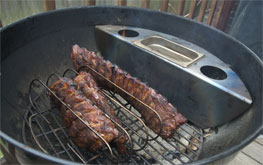 Smoking. Can the grill smoke meats? If it can, you don't need a separate dedicated standalone smoker. To smoke properly, you need a tight-fitting lid with good vent control. You must be able to control airflow. For example, the Weber Kettle charcoal grill does a fine job of smoking because it has excellent airflow control and a tight lid. Add the $50 Smokenator and you can compete on the circuit.
Smoking. Can the grill smoke meats? If it can, you don't need a separate dedicated standalone smoker. To smoke properly, you need a tight-fitting lid with good vent control. You must be able to control airflow. For example, the Weber Kettle charcoal grill does a fine job of smoking because it has excellent airflow control and a tight lid. Add the $50 Smokenator and you can compete on the circuit.
Burners. On gas grills, aluminum burners burn out and cast iron burners rust. You want stainless or brass burners. If you will only have one grill, try to get one with an infrared or sear burner so you can do steaks properly. Also, pay attention to which way the burners run, left to right, or front to back. I prefer burners that run front to back because it is easier to set up multiple heat zones, hot, medium, and low for cooking different foods at once or for indirect cooking.
Starter or igniter. Gas grills need a starter or igniter. Some are electric and need a battery. Others use a button or dial to generate a spark. Electronic starters are faster, but this is not a deal breaker.
Materials, workmanship, and durability. The best grills are cast aluminum, cast iron, enamel bonded steel, and stainless steel. Stainless and aluminum will not rust. Cast iron can rust if it is not painted properly. Enamel will not rust unless you chip it. How well is it painted? How heavy is the metal? Heavy steel holds and distributes heat better than thin steel. Is the metal thick enough that it will not warp? How are the welds? Does it have sharp edges? Sturdy legs? Big hinges and latches? A lot of plastic parts? Do the moving parts look like they'll last? Stainless is all the rage, but it shows dirt, dust, grease, and rain spots. If you are a neat freak you'll go crazy polishing your stainless grill. Also, stainless tends to be thinner and provides less heat retention. Not all stainless is the same. Some are thicker, and some have more chromium and nickel in the alloy, both desirable contents. Look for 300 series or lower number stainless. Magnetic stainless will pit and corrode faster so bring a magnet when you shop and use a cover. Stainless is also more expensive. I prefer steel or cast aluminum. They hold heat better, are cheaper, and are not such a pain to clean.
Grates. Most grilling is by radiation or convection, but where the food is in contact with the grates, the cooking is by conduction and that's how you get good crunchy grill marks. Chrome or nickel coated wire grates don't leave a wide mark and tend to rust. Cast iron grates conduct heat to the meat well but they need to be oiled to keep them from rusting. I like baked-on porcelain or stainless grates where each rung is about 1/4" wide or more. They give great wide grill marks and they are easy to clean. Best of all: Porcelain coated cast iron. But you will need a forklift to remove them. On charcoal grills, some manufacturers offer hinged grates or access doors so you can easily add more coals when necessary.
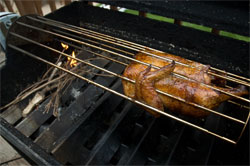 Rotisserie. Rotisserie cooking is an excellent method for cooking whole chickens and turkeys. Most charcoal grills cannot be outfitted with a rotisserie and most gas grills can. You need access to electricity for their electric motors to run. A good rotisserie should have a sturdy motor and a counterweight to balance the load. The best rotisseries are basket types rather than the more common spear that pierces the meat and cooks it in the center. Rotisseries usually cost extra. If they only have the spear model, skip it and get a basket type from E-Z Que.
Rotisserie. Rotisserie cooking is an excellent method for cooking whole chickens and turkeys. Most charcoal grills cannot be outfitted with a rotisserie and most gas grills can. You need access to electricity for their electric motors to run. A good rotisserie should have a sturdy motor and a counterweight to balance the load. The best rotisseries are basket types rather than the more common spear that pierces the meat and cooks it in the center. Rotisseries usually cost extra. If they only have the spear model, skip it and get a basket type from E-Z Que.
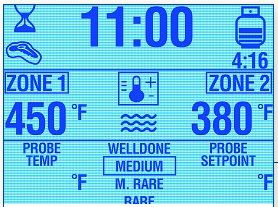 Thermometer. Most thermometers on grills are bi-metallic and not accurate. Usually the temp at the meat height is different than the temp in the hood where the thermometer lives. Get a good digital thermometer on a cable that you can place next to the meat. If you do, then it doesn't matter how bad the grill's thermometer is. A harbinger of things to come? The Blue Ember iQue Gas Grill has a digital timer, a digital probe for the meat with an alarm that alerts you when the meat is at the desired temp (at right). It even claims to be able to tell you how much fuel left in the tank in minutes.
Thermometer. Most thermometers on grills are bi-metallic and not accurate. Usually the temp at the meat height is different than the temp in the hood where the thermometer lives. Get a good digital thermometer on a cable that you can place next to the meat. If you do, then it doesn't matter how bad the grill's thermometer is. A harbinger of things to come? The Blue Ember iQue Gas Grill has a digital timer, a digital probe for the meat with an alarm that alerts you when the meat is at the desired temp (at right). It even claims to be able to tell you how much fuel left in the tank in minutes.
Dual fuel. If you are buying a liquid propane (LP) gas grill, can it be adapted to household natural gas if you want to do this? How much does the adapter kit cost?
Wheels. You may want to move the thing when you set it up, so it should have wheels or come apart easily. On really rainy days I roll my gasser right up to the back door so I don't have to go out. If it has wheels, how sturdy are they, and are they large enough to roll smoothly on a rough surface such a deck, concrete, pavers, or the lawn?
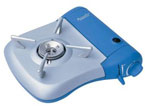 Side burners. A side burner is a handy, but not necessary feature. They're great for making side dishes or warming sauces. A few even have a griddle that sits over them, perfect for eggs, fish, or grilled cheese sandwiches. Instead of paying $200 for a built-in side burner, you can buy a standalone burner cheap.
Side burners. A side burner is a handy, but not necessary feature. They're great for making side dishes or warming sauces. A few even have a griddle that sits over them, perfect for eggs, fish, or grilled cheese sandwiches. Instead of paying $200 for a built-in side burner, you can buy a standalone burner cheap.
Assembly. Most grills come knocked down and they can be tricky to assemble. If you don't have the necessary time or tools, or aren't confident in your skills, many merchants will assemble for you. For a fee.
Manual. Is there a manual? Was it translated from Chinese by someone who does not speak English very well?
Cookbook. Some grills come with a nice cookbook. If not, you'll have to buy my book when it comes out.
Ease of cleaning. Can you remove ash or grease easily? Some charcoal grills have ash collectors, and some gassers have grease collectors. Do the grates come out easily? Can you get at the burners to clean or replace them?
Warranty and support. What kind of warranty and/or guarantee does it come with. On gassers, check the warranty on the burners. What is the dealer's reputation? Is there a phone number and email for tech support? Is the website informative? How about the manual? What if you need parts? How long have they been in business?
Safety. Is it child and pet safe? Are electrical parts safe from rain and snow?
Footprint. Can it fit in on your condo's balcony?
Other accessories. Cover? Natural gas adapter? Propane fuel gauge? Night lights? Cutting boards? Storage? Griddles? Woks? Steamers? Drink holders? Can openers? Surround sound?
Color. Ask your wife.
Text and photos Copyright (c) 2009 By Craig "Meathead" Goldwyn, AmazingRibs.com, and all rights are reserved. Click here for information on reprint rights.